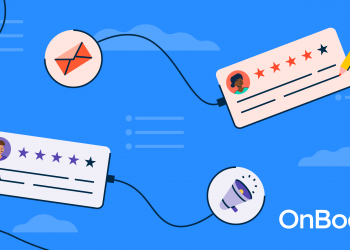When it comes to marketing, personalization is everything.
Knowing your target audience and creating a buyer persona empowers businesses to tailor their marketing campaigns to fulfill specific needs. And marketing automation is a robust tool that can make this process convenient to achieve the desired results.
Automation converts every marketing effort to a bigger scale by bringing more leads that result in more conversions and sales. Businesses use marketing automation software to automate redundant marketing processes, streamline workflows, and track marketing campaigns.
What are the benefits of marketing automation?
At its core, marketing automation is all about optimization. From saving time and resources to generating more revenue and nurturing leads, marketing automation goes beyond automating repetitive marketing tasks like follow-ups, sales pipelines, and lead acquisition.
How to benefit from marketing automation?
Automation has become necessary for most entrepreneurs to streamline their businesses in the digital age. So what steps can you take to implement marketing automation?
1. Social media integration
Having an appealing social media presence is the prerequisite for success. According to Datareportal’s July 2022 global overview, 59% of the world’s population uses social media and spends an average of two and a half hours daily.
This creates a great marketing opportunity for your business and a massive hustle at the same time. Your employees can’t possibly do every social media marketing task. With automation software, you can hire fewer people to handle social media and deliver better results simultaneously.
There are several social media automation tools out there that allow you to create posts beforehand and schedule them across the week. You can also post on different social media platforms simultaneously. Some advanced software can even offer you the best time to post based on previous research. This results in hours of free time saved on these tasks.
Others can show you hot topics and trending hashtags to help your team to create the most relevant content that gets more views and engagements. Some even allow you to address comments from different social media profiles from the same app.
Regardless, there’s a social media management tool out there that best suits your company’s needs for reaping the benefits of marketing automation.
2. Lead scoring
Lead scoring is a sales automation mechanism that allows you to rate leads with software. You don’t need to have people judging leads manually; you only have to configure the algorithm. Ultimately, you have to work with the list of marketing-qualified leads (MQLs).
Here’s what you must consider when creating your lead scoring system to ensure you’re focusing your efforts on the right people.
- Create a list of actions and characteristics that make up an MQL for your company. Start with small steps like creating a marketing email and eventually progress to the webinar or newsletter signups.
- Include personal characteristics to the list of your most converting clients. For instance, if the bulk of your clients is 30-year-old private entrepreneurs, give them extra scores to make your sales team focus on them.
- Decide on the number of points you award for each action and the point range. For instance, you can give five points for sharing on social media. If a person shares only one post monthly, they get one point. They get all five points if they share more than four a month.
- Work out lead tiers to represent how likely a lead is to convert. For instance, if a lead has five points out of 50, they need more nurturing. If they have 45, you need to reach out with an offer. Work out the minimum number of points a lead must have to convert, so your team knows when to contact them.
- Don’t forget about the other leads. You have to handle them differently. For instance, a lead that doesn’t share your content may need an email asking about their content consumption preferences.
You might feel ready to create your lead scoring system from scratch, but it can be expensive. Using lead scoring software will be more reasonable than developing your own.
3. Email automation
Source: Tomoson
Influencer marketing works because people trust their peers more than companies. Email marketing works because people who give you an email address already like your product. Besides, it’s a great way to deliver discounts, and who can resist one?
Many companies offer email automation for personalization, mass sending, and scheduling bulk emails automatically. You only have to configure it once and add content and discounts to emails when needed. Each email will have the name and the company of the addressee mentioned to make sure they open it.
Those are the features of good email marketing automation software. A great tool allows you to segment your email list to make your email campaign personalized. You can easily integrate your lead scoring system to deliver even better results.
30%
of sales-related activities can be easily automated with today’s technology.
Source: McKinsey & Company
4. Personalized marketing
Most website owners face the challenge of not being able to convert a first-time visitor into a loyal customer. Fortunately, one of the benefits of marketing automation is leveraging the power of personalized marketing. Since your team will spend less time on repetitive tasks, it can create a custom user journey through personalized content.
But how does marketing automation help with this? Marketing automation software simplifies delivering the right content to the right buyer at the right time. Once you know your visitors and what they are looking for, you can segment them as per demographics, behavior, characteristics, and needs. This process, in turn, will personalize the connections with these leads and increases user engagement.
Marketing automation tools also gather insights from personalized content like which emails get the most clicks, which social media posts have the highest engagement, and if they convert into website traffic. These insights can go a long way toward enhancing your lead scoring and nurturing process before passing them along to sales.
5. High ROI
In addition to automating processes, nurturing leads, and generating revenue, marketing automation also delivers a great ROI. When you target customers more specifically, the marketing resources get used more efficiently.
Companies that automate marketing processes experience better benefits and outcomes in their digital marketing campaigns. The success comes in the form of high conversion rates, which means more new customers, ultimately resulting in multiplied revenue.
Moreover, the added benefits of reduced workload, higher productivity levels, and improved conversion rates all add up to one significant use: increased ROI.
Another benefit of marketing automation is that you only have to create personalized content and tailored campaigns once and let the software do the rest of the work independently. Of course, the strategies need to be revised over time as you learn from the input you get from the campaigns. But by making this initial effort, you can end up reaping the advantages for many years.
75%
of companies that implement marketing automation witness ROI in just 12 months.
Source: WebFX
6. Comprehensive data and analytics
One of the best benefits of marketing automation is the ability to gather data on your existing customers and potential leads. These insights empower entrepreneurs to make informed data-driven decisions that ultimately optimize the use of their budget, efforts, and resources.
Automation also analyzes marketing campaign metrics like open rate, click-through rate, conversions, demo requests, and free trial signups. So, leaders can quickly identify which campaigns are working for them and which ones need to be modified. Doing so unlocks insights into how to gain more customer engagement and revenue.
Moreover, the collected data helps the sales team be more productive by delivering high-quality leads ready to be converted. Marketing automation enables teams to gain better insights into who visits your websites, who is prepared to purchase, and who is looking for something else. So, you can spend appropriate time nurturing those leads instead of chasing the wrong crowd.
Besides, building trust and strengthening relationships is the key to converting a one-time visitor into a loyal paying customer. And when most of your menial tasks have been automated, your team can easily invest time in building relationships with prospects without the need to hire more people who can focus on one task at a time. So your staffing expenses remain stable while sales revenue keeps growing.
7. Trigger marketing
Leaving your marketing materials out there for the world is not enough anymore. Delivering your offers when a lead is ready to listen to them is a better bet. It goes beyond simply showing related posts on your blog, too.
Here’s when you want to contact your leads:
- After searching for something specific on the website
- After making a purchase
- After abandoning a shopping cart
- After a key converting action like visiting a pricelist
- After a social media share
- After a prolonged absence from the website
Each situation needs a different approach. Anytime someone shares your content on social media, show them a thank-you pop-up and offer to subscribe to your account. They’ve already shown they like your content, so they’re more likely to carry on.
Leverage email automation to send follow-ups to people who have abandoned their cart or were looking for something on the website. Offer them the information they were looking for, a product related to the purchase, or a reason to return to the cart. You will increase sales without paying attention once the automation is set up.
Finally, if your CRM allows for live tracking of consumer behavior, your sales agents can call leads browsing the key pages or having trouble finding what they want. Be careful with this, as some people may find it intrusive.
Choose the path that leads to conversion.
While automation in marketing is almost mainstream in the digital age, we’re still just at the beginning of it all. Despite the potential, only one in four companies have automated at least one of their sales processes.
Since many automation techniques and tools are interconnected, figuring out the best combination for your business is critical. Lead scoring is the most efficient when used with trigger marketing, and trigger marketing works best with email automation. Social media automation will give you essential insights necessary for lead scoring.
Acquiring and retaining more customers is possible through intelligent decision-making that is easily powered by marketing automation. And once you automate one thing, you start automating all of them, resulting in improved user experience and sales growth.
Want to learn more about marketing automation? Give our extensive rundown of marketing automation best practices and challenges a quick peek!
Source by learn.g2.com











